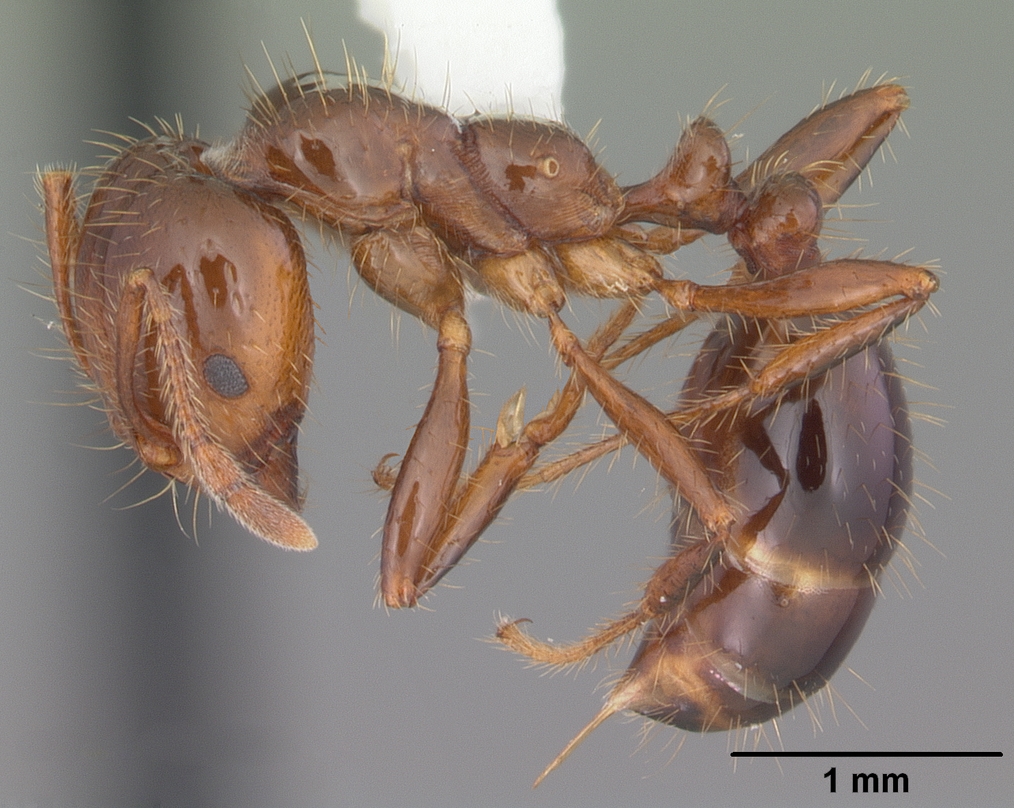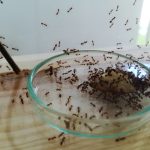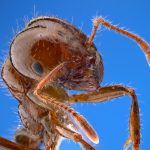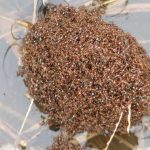Red Imported Fire Ant (RIFA)
Solenopsis invicta

- Regulatory Status: Hawaii Injurious Wildlife. HDOA Pest for Control (HAR 69A)
- What You Can Do: Send in and collect unfamiliar ants you find for identification. (Request an Ant Collection Kit)
- Not known to be established in Hawai’i
Photo credit above: (April Nobile / © AntWeb.org / CC BY-SA 3.0)
Photo credit above from left to right:
- Solenopsis invicta in petri dish for size.
- Solenopsis invicta – fire ant worker. Specimen from Brackenridge Field Laboratory, Austin, Texas, USA.
- Red Imported Fire Ants (Solenopsis invicta) – caught in a flood.
DESCRIPTION:
- This ant is small, reddish-brown and can vary in size, from 3-6 mm (1/8-1/4 in).
- Its head size is always the same proportion to body size, with no “big-headed” workers.
- It has an opaque shiny black abdomen.
- The ants build dome shaped mounds of fine soil, usually in sunny areas, but can appear anywhere. These mounds are variable in size, from a few inches wide to 0.6 m (2 ft) and have no visible opening.
- When their mounds are disturbed, the Red Imported Fire Ant (RIFA) will aggressively swarm out of the nest and sting anything with proximity. These stings cause blisters filled with white pus that last for several days.
- Look alike Species -Tropical fire ant (Solenopsis geminata): The tropical fire ant is common throughout Hawai’i. A microscope is required to tell the difference between the tropical and red imported fire ants. Please collect and send in ants for identification.
- Native to South America, RIFA were accidentally introduced to Alabama in the 1930s as a stowaway in cargo, and have since spread across the southern United States, Australia, Hong Kong and Taiwan.
- RIFA could easily arrive hidden in cargo, carried by planes or ships, or even in infested mail parcels, as was seen in 1991, when an infested package from Florida was intercepted at a Honolulu post office.
IMPACTS:
- “Economic: $1 billion in damages in the USA alone. In Australia over the past 30 years, economic loss was estimated at $6.7 billion. Projected estimates for introduction and establishment in Hawaii is at $211 million per year.” (Plant Pono)
- “Persons with sensitivities can have a severe allergic reaction causing anaphylaxis. Anaphylaxis occurs in .6% to 6% of people who are stung and more than 80 deaths have been reported (deShazo et al., 1999).” (Plant Pono)
- In the U.S., millions of people are stung each year by RIFA. They pose a serious threat to human health. Large numbers of ants will rapidly swarm on and relentlessly sting anything unfortunate enough to disturb them.
- RIFA stings cause blisters filled with white pus which lasts for several days.
- “Newborn livestock and poultry are vulnerable to attack by ants.” (UC Riverside)
- “Foraging ants can clog irrigation lines and short-circuit electrical systems.” (UC Riverside)
- Can also cause damage to pets, wildlife, and crops.
- Harms native baby birds in nests, native wildlife and greatly reduces biodiversity.
ERADICATION & CONTROL METHODS:
- “For professionals and residents carrying out their own management programs, fire ant baits are recommended because they are inexpensive, highly effective, and safe for the environment.” (UC IPM)
- Insect growth regulators that decrease egg production and prevent worker ant development are often used. However, they are slow acting, taking 4-6 weeks to reach maximum efficacy. These treatments do not kill adult worker ants, so colonies will exist until natural die off of adults occurs.
- Organic insecticides, hot water, excavation (digging up the mound), and mound drenches are some other control methods that can be used.
- For biocontrol: “The USDA has released six species of phorid fly, including Pseudacteon cultellatus to help control workers in multi-queen colonies, to control fire ants in the southeastern U.S. All of the released species have been established. At least three have become widely established and expanded beyond their release sites.” (IFAS extension)
WHAT YOU CAN DO:
- Send in and collect unfamiliar ants you find for identification. (Request an Ant Collection Kit)
- Report suspicious ants to 643Pest.org, however after reporting, ants will need to be collected for identification. Link above.
-
Collecting ants is simple. “All you need is some peanut butter and a chopstick. Smear the bait on your stick, leave it in a shady place, and check back on it in an hour. If there are any ants on the stick, send them to us!” Says Monte Tudor-Long, the little fire ant crew leader with MISC . (Maui News)
- “Survey and inspect soil and any articles of trade or shipping equipment coming from areas known to be infested with S. invicta for the presence of ants.” (Plant Pono)
For more information



